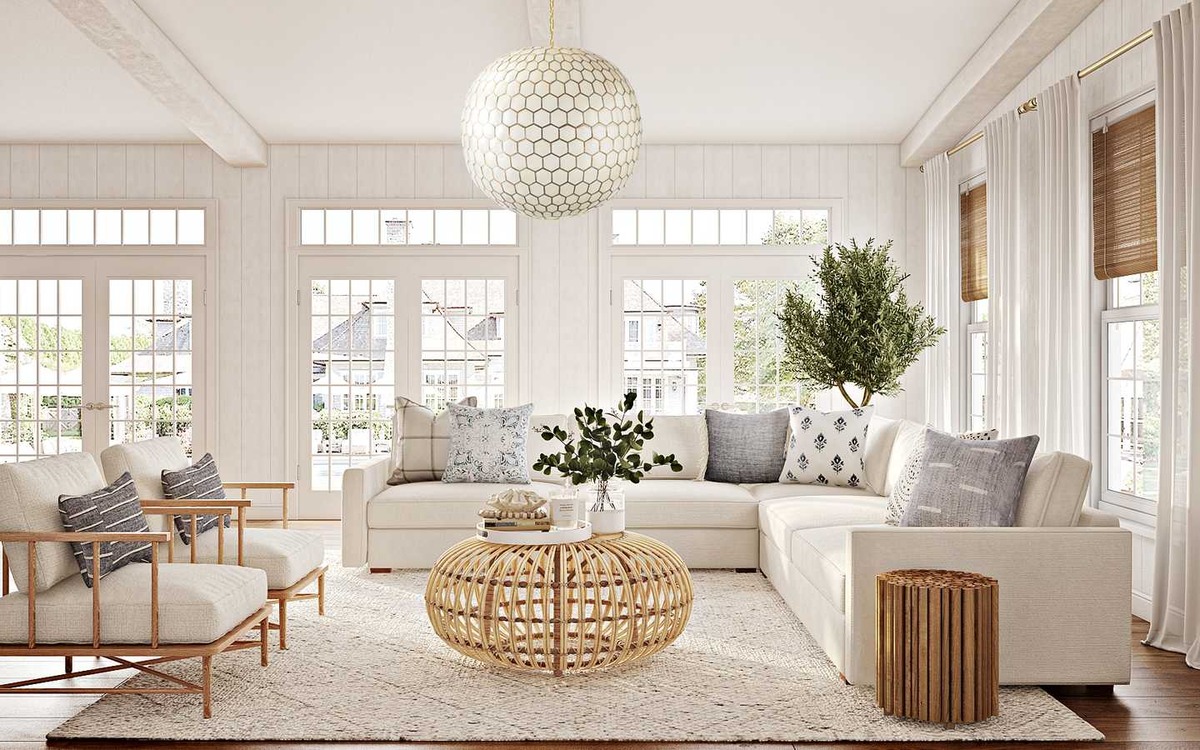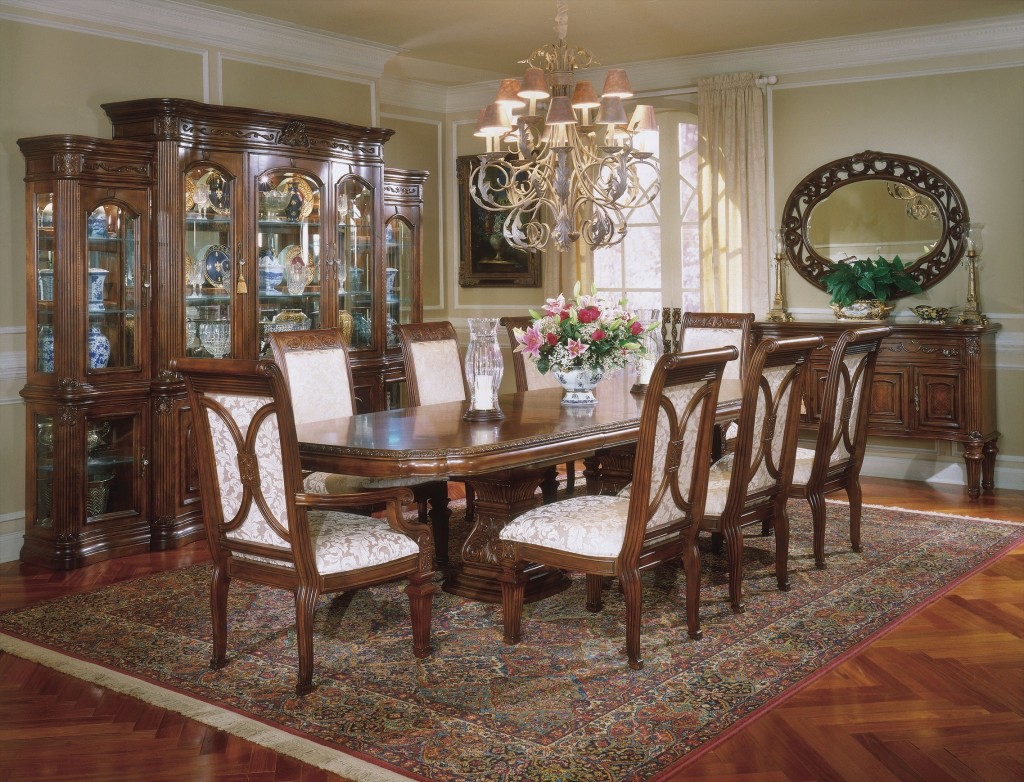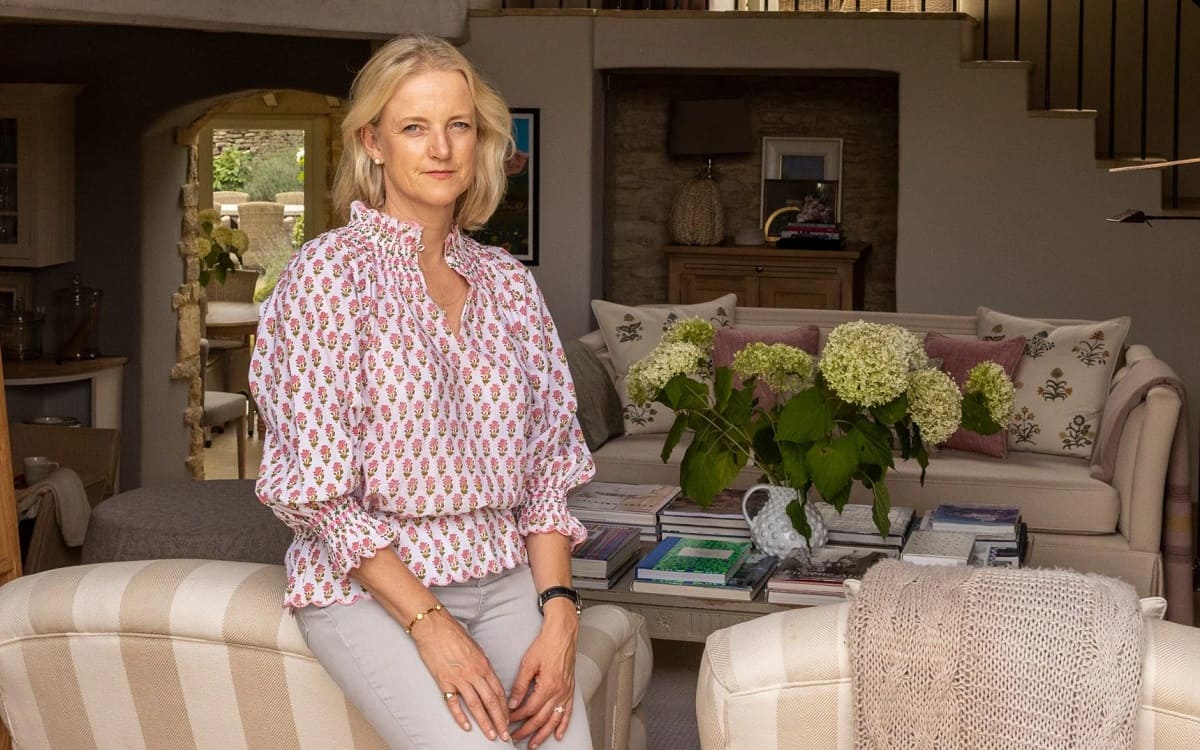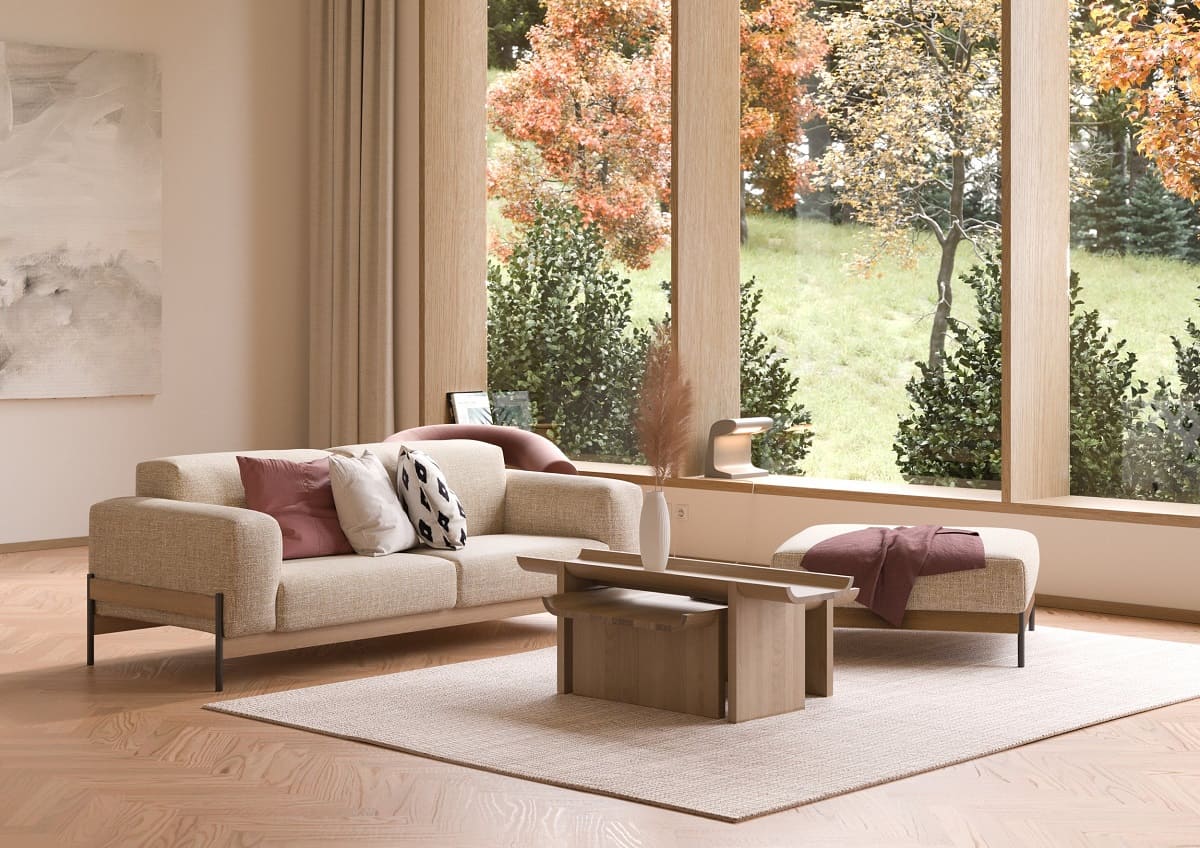Home>Interior Design>Traditional Decorating Ideas – Inspiration For Timeless Interiors


Interior Design
Traditional Decorating Ideas – Inspiration For Timeless Interiors
Modified: January 6, 2024
Discover traditional decorating ideas for creating timeless interiors. Get inspired by our interior design tips and transform your space into a masterpiece.
(Many of the links in this article redirect to a specific reviewed product. Your purchase of these products through affiliate links helps to generate commission for Storables.com, at no extra cost. Learn more)
Introduction
In the world of interior design, trends may come and go, but there is a classic style that stands the test of time – traditional decorating. Rooted in history and elegance, traditional interiors bring a sense of warmth, comfort, and sophistication to any space. Whether you live in a modern apartment or a historic home, incorporating traditional elements into your décor adds a touch of timeless beauty.
Traditional decorating is all about creating a harmonious balance between old-world charm and modern convenience. It embraces rich colors, intricate patterns, vintage furniture, and architectural details that exude a sense of history and craftsmanship. By blending these elements together, you can transform your home into a haven of timeless elegance and sophistication.
Choosing a color palette is an essential first step in traditional decorating. Rich, warm hues like deep browns, burgundies, and forest greens serve as a perfect backdrop for creating a cozy and inviting atmosphere. Soft, muted tones like creams and ivories can also be used to add a touch of serenity and elegance. Accents of gold or brass can be incorporated to add a touch of opulence.
Incorporating vintage furniture is another key element of traditional decorating. Antique pieces with intricate carvings and craftsmanship instantly add character and charm to a space. From ornate bed frames to elegant dining room sets, vintage furniture pieces provide a sense of history and style. Mixing them with modern pieces or reupholstering them with updated fabrics can create a unique and eclectic look.
Traditional patterns and prints play a significant role in bringing a sense of authenticity to traditional interiors. Think damask, floral, toile, or houndstooth patterns. They can be incorporated into upholstery, curtains, or wallpaper to add visual interest and create a cohesive look. Mixing and matching patterns can be done to create a dynamic and layered effect.
Adding architectural details is another hallmark of traditional decorating. Crown moldings, chair rails, wainscoting, and coffered ceilings are just a few examples of architectural features that can be incorporated to elevate the overall design. These details give a room a sense of grandeur and lend a touch of timeless elegance.
Key Takeaways:
- Embrace the timeless elegance of traditional decorating by incorporating rich colors, vintage furniture, and architectural details to create a sophisticated and warm interior with a touch of history and charm.
- Create a cozy and inviting traditional-inspired space by layering textures, incorporating natural materials, and showcasing personal touches to achieve a warm and welcoming atmosphere that exudes timeless beauty.
Choosing a Color Palette
When it comes to traditional decorating, selecting the right color palette is crucial to create a harmonious and visually pleasing space. Traditional interiors often feature rich, warm colors that evoke a sense of elegance and sophistication. Here are some tips to help you choose the perfect color palette for your traditional-inspired interior.
1. Embrace Rich and Warm Hues: Traditional decorating incorporates deep, earthy tones that create a cozy and intimate atmosphere. Shades like deep browns, burgundies, forest greens, and navy blues serve as a perfect backdrop for traditional interiors. These colors create a sense of depth and warmth, setting the stage for a timeless and elegant design.
2. Soft and Muted Tones: In addition to the rich hues, incorporating soft and muted tones can add a touch of serenity and elegance to your space. Creams, ivories, and pale yellows can be used as accent colors or as the primary color in a room. These light tones help to create an airy and sophisticated ambiance.
3. Accents of Gold or Brass: To add a touch of opulence and glamour, consider incorporating accents of gold or brass into your color palette. Whether it’s a gilded mirror frame, metallic accessories, or lighting fixtures with brass finishes, these accents bring a sense of luxury to traditional interiors.
4. Mixing Colors: Traditional decorating allows you to play with color combinations to create a dynamic and visually appealing space. Consider using a combination of warm and cool colors to add depth and balance to the room. For example, pair a deep navy blue with a soft cream or a rich burgundy with a pale yellow to create a striking contrast.
5. Consider the Natural Light: When choosing your color palette, it’s important to consider the amount of natural light in the room. Rooms with ample natural light can handle darker and richer colors, while rooms with limited natural light may benefit from lighter and softer tones to create an open and airy feel.
Remember, the key to choosing a color palette for traditional decorating is to create a cohesive and balanced look. Consider the overall mood you want to create in your space and choose colors that evoke that desired ambiance. By incorporating rich, warm hues and balancing them with softer tones and metallic accents, you can create a timeless and elegant color palette for your traditional-inspired interior.
Incorporating Vintage Furniture
One of the defining features of traditional decorating is the use of vintage furniture. Incorporating antique pieces into your interior design adds character, charm, and a sense of history to your space. Here are some tips to help you seamlessly integrate vintage furniture into your traditional-inspired décor.
1. Embrace the Classics: Vintage furniture often embodies classic styles like Queen Anne, Chippendale, or Louis XVI. Look for pieces with intricate carvings, graceful curves, and timeless silhouettes. These pieces not only add visual interest but also serve as conversation starters and focal points in the room.
2. Mix Old and New: Balance vintage furniture with more modern or contemporary pieces to create a unique and eclectic look. Pair an antique dining table with sleek, upholstered chairs or place a vintage secretary desk in a room with minimalist décor. This blending of styles adds depth and interest to your space.
3. Reupholster and Refresh: Don’t be afraid to give new life to vintage furniture by reupholstering or refinishing them. Recovering chairs and sofas with modern fabrics and patterns can give them a fresh and updated look while still maintaining their classic appeal. Refinishing wooden furniture can also enhance their natural beauty and bring them back to their former glory.
4. Create a Statement Piece: Choose a standout vintage furniture piece to serve as the focal point of the room. This could be a grand, hand-carved bed frame, an ornate armoire, or a beautifully crafted sideboard. Let this piece shine and build the rest of the décor around it to create a cohesive and impactful design.
5. Find Hidden Gems: Explore flea markets, antique stores, and online platforms to discover unique and hidden gems. Look for items with interesting details, quality craftsmanship, and a story to tell. These one-of-a-kind finds will add authenticity and character to your traditional-inspired interior.
6. Create Vintage-inspired Groupings: Group vintage furniture pieces together to create cozy and inviting seating areas or vignettes. For example, arrange a set of vintage armchairs around a coffee table and add a vintage floor lamp to create a cozy reading nook. This not only adds functionality but also enhances the nostalgic feel of your space.
Incorporating vintage furniture into your traditional-inspired interior adds a sense of nostalgia and authenticity to your space. Whether it’s a single standout piece or a collection of vintage treasures, these furniture items become the focal point and soul of your décor. So, embrace the charm of vintage furniture and create a space that is truly timeless and unique.
Using Traditional Patterns and Prints
In traditional decorating, patterns and prints play a significant role in creating a cohesive and visually striking interior. Traditional patterns and prints add depth, interest, and a sense of authenticity to your décor. Here are some ideas on how to incorporate traditional patterns and prints into your traditional-inspired space.
1. Damask: Damask is a classic pattern that originated in the Middle East and became popular in European design. It features intricate motifs and a rich texture, typically on a satin or matte background. Use damask patterns on upholstery, curtains, or bedding to add elegance and sophistication to the room.
2. Floral: Floral patterns are a staple of traditional decorating. Whether it’s large-scale roses or delicate wildflowers, floral prints bring a sense of nature and femininity to your space. Incorporate floral patterns on wallpaper, upholstery, or even in artwork to add a touch of romantic charm.
3. Toile: Toile patterns originated from 18th-century France and are known for their intricate scenes and pastoral motifs. Typical toile prints depict landscapes, animals, or historical events. Use toile patterns on draperies, bedding, or accents like throw pillows to add a touch of elegance and a nod to history.
4. Houndstooth: Houndstooth is a classic pattern characterized by its small, broken checks. It adds a sophisticated and tailored look to any space. Incorporate houndstooth patterns on upholstery, rugs, or even as a subtle accent in accessories like throw blankets or lampshades.
5. Stripes: Stripes are a versatile pattern that can be used in traditional décor to create a timeless and tailored look. Horizontal stripes add a sense of width and elegance, while vertical stripes can elongate the space. Use striped patterns on curtains, rugs, or even as a feature wall to add visual interest.
6. Plaid: Plaid patterns are traditionally associated with Scottish or Tartan designs and bring a cozy and rustic feel to a space. Incorporate plaid patterns on upholstery, throw pillows, or even as draperies to add warmth and a touch of traditional charm to your interior.
When incorporating traditional patterns and prints into your décor, remember to balance them with solid colors and textures to avoid overwhelming the space. Mixing different patterns can also add interest and depth to your design. Don’t be afraid to experiment and layer patterns to create a personalized and visually appealing look.
By incorporating traditional patterns and prints into your traditional-inspired interior, you can infuse your space with character, charm, and a sense of history. So, embrace the beauty of traditional patterns and prints to create a visually captivating and timeless design.
Adding Architectural Details
One of the key elements of traditional decorating is the incorporation of architectural details. These details not only add visual interest and depth to your space but also lend a touch of timeless elegance and sophistication. Here are some ideas on how to add architectural details to your traditional-inspired interior.
1. Crown Molding: Crown molding is a classic architectural feature that adds a sense of grandeur and refinement to a room. It can be installed where the walls meet the ceiling to create a decorative border. Choose a style of crown molding that complements the overall aesthetic of your space and consider painting it in a contrasting color to make it stand out.
2. Chair Rails: Chair rails are horizontal moldings that are typically installed at the height of a chairback. They serve both a functional and decorative purpose by protecting the walls from chair damage and bringing an added layer of elegance to the space. Consider painting the wall below the chair rail in a different color or using wallpaper to create a striking visual contrast.
3. Wainscoting: Wainscoting is a timeless architectural feature that involves installing panels on the lower half of the walls. This technique adds texture, depth, and a sense of craftsmanship to your space. Wainscoting can be created using various materials such as wood, beadboard, or even wallpaper. It instantly transforms a room and gives it a classic, sophisticated look.
4. Coffered Ceilings: Coffered ceilings are a stunning architectural detail that adds a sense of depth and elegance to any room. They consist of a series of recessed panels or coffers that are typically framed by decorative moldings. Coffered ceilings can be created using wood, plaster, or other decorative materials. They bring a sense of luxury and refinement to your traditional-inspired interior.
5. Decorative Columns: If you have an open floor plan or a large room, incorporating decorative columns can add a touch of grandeur and architectural interest. Columns can be freestanding or used in combination with half-walls to define separate areas within a space. Consider using columns with intricate carvings or fluting details to enhance the traditional aesthetic.
6. Window Casings and Trim: Pay attention to the details around your windows by adding decorative casings and trim. This can be accomplished by installing crown molding, rosettes, or intricate trimwork around the window frames. These architectural details draw attention to the windows and add a sense of elegance to the overall design.
When adding architectural details, it’s essential to ensure that they fit harmoniously with the overall style of your space. Consider the proportions and scale of the room to ensure that the architectural features complement the existing elements. Don’t be afraid to mix and match different architectural details to create a unique and personalized look.
By incorporating these architectural details into your traditional-inspired interior, you can elevate the overall design and create a space that exudes timeless elegance and sophistication. So, embrace the beauty of architectural elements and transform your home into a haven of classic charm.
Read more: How To Fix E2 Error In A Washing Machine
Incorporating Natural Materials
In traditional decorating, the use of natural materials is essential to create a sense of warmth, authenticity, and connection to the natural world. By incorporating these elements into your interior design, you can achieve a timeless and harmonious space. Here are some ideas on how to incorporate natural materials into your traditional-inspired interior.
1. Wood: Wood is a fundamental element of traditional decorating. It adds warmth, texture, and a sense of craftsmanship to a space. Incorporate wood through furniture pieces, flooring, trim, or even exposed beams or columns. Opt for rich, dark finishes like mahogany or cherry for a traditional look, or lighter tones like oak for a more relaxed ambiance.
2. Stone: Stone is another natural material that can add a sense of timeless beauty to your traditional-inspired space. Whether it’s a stone fireplace, a feature wall, or stone flooring, it brings a sense of permanence and durability. Consider incorporating natural stone elements in your space to create a stunning focal point or to add depth and texture.
3. Natural Fabrics: When it comes to selecting fabrics for upholstery, curtains, or bedding, choose natural fibers like cotton, linen, or silk. These materials not only provide a soft and luxurious feel but also add a sense of authenticity and comfort to your space. Look for fabrics in earthy tones or classic patterns to maintain the traditional aesthetic.
4. Leather: Leather is a classic material that adds a touch of elegance and luxury to traditional interiors. Incorporate leather furniture pieces like sofas, armchairs, or ottomans to create a cozy and inviting seating area. Opt for rich, warm tones like caramel, deep brown, or burgundy to create a sophisticated and timeless look.
5. Natural Fibers: Bring the beauty of natural fibers into your space through rugs, baskets, or lampshades. Jute, sisal, or seagrass rugs add texture and warmth to the floor, while woven baskets provide storage solutions with a touch of natural beauty. Lampshades made from natural materials like rattan or woven paper create a soft and organic glow in your lighting fixtures.
6. Plants and Greenery: Incorporating plants and greenery is an excellent way to bring the outdoors in and add life to your traditional-inspired interior. Place potted plants or arrangements of fresh flowers throughout your space to create a refreshing and inviting atmosphere. Select plants that thrive indoors and require minimal maintenance to ensure they stay vibrant and healthy.
When incorporating natural materials into your traditional-inspired interior, strive for a balance between elegance and comfort. Choose materials that align with the overall aesthetic of your space and enhance the traditional ambiance. By incorporating these elements, you can create a timeless and harmonious environment that connects you to the beauty of nature.
When decorating traditionally, focus on classic furniture pieces, rich colors, and elegant fabrics to create a timeless and sophisticated interior. Incorporate antique or vintage items for added character and charm.
Layering Textures
When it comes to traditional decorating, layering textures is key to creating a rich and inviting interior. Texture adds depth, visual interest, and a tactile experience to your space. By incorporating different textures into your traditional-inspired design, you can create a cozy and visually captivating environment. Here are some ways to effectively layer textures in your space.
1. Upholstery: Start by selecting upholstery fabrics with different textures. Mix and match fabrics like velvet, linen, suede, or brocade to create depth and variety. Consider using a combination of smooth and textured fabrics on sofas, accent chairs, and ottomans to add visual interest and create a comfortable seating area.
2. Pillows and Throws: Layering pillows and throws is a great way to add texture and coziness to your space. Choose pillows and throws with varying fabrics, such as faux fur, cable-knit, or embroidered textiles. Play with different patterns, colors, and sizes to create a visually dynamic arrangement. Drape a plush throw over a chair or sofa to invite guests to curl up and relax.
3. Rugs: Rugs are an excellent way to add texture and define different areas within a room. Layer rugs of various materials, such as a soft wool rug over a sisal or jute rug for a layered effect. This not only adds visual interest but also enhances the tactile experience underfoot. Consider patterns like geometric designs or traditional Persian motifs to further enhance the texture in your traditional-inspired space.
4. Window Treatments: Incorporate textured window treatments to add depth to your windows. Look for fabrics like jacquard, linen, or silk that feature intricate weaves or patterns. Consider adding window treatments like Roman shades or drapes with subtle textures to create a visually appealing and luxurious feel.
5. Furniture and Accessories: Incorporate furniture and accessories with different textures to add visual interest and variety. Mix in pieces made of wood, metal, glass, or ceramics to create a balanced and layered look. For example, pair a polished wood coffee table with a metal and glass side table, and accessorize with ceramic vases or metallic sculptures for an eclectic and textured arrangement.
6. Wallcoverings: Lastly, don’t forget about the walls when layering textures. Consider using wallpaper with textured finishes like grasscloth, embossed patterns, or faux finishes. This adds visual interest and depth to your walls, creating a captivating backdrop for your traditional-inspired decor.
When layering textures, it’s important to strike a balance between different elements. Mix textures in varying degrees to create a cohesive and visually appealing composition. Play with contrasting textures, such as smooth and rough, shiny and matte, or soft and coarse, to create a sense of balance and harmony in your space.
By layering textures in your traditional-inspired interior, you can create a visually captivating and inviting environment. So, embrace the beauty of texture and transform your space into a cozy and visually dynamic haven of traditional elegance.
Dressing Windows with Classic Treatments
When it comes to traditional decorating, dressing windows with classic treatments is an important element in achieving a timeless and elegant interior. Window treatments not only provide privacy and light control but also add texture, visual interest, and a sense of luxury to your space. Here are some classic window treatment ideas for your traditional-inspired interior.
1. Curtains: Floor-length curtains are a staple in traditional decorating. Choose fabrics like silk, linen, or velvet in rich, elegant colors to create a luxurious and grand look. Opt for curtains with pleats, goblet tops, or tab tops to add a sense of opulence and sophistication. Make sure the curtains are long enough to pool gently on the floor for an added touch of elegance.
2. Drapes: Drapes are another classic window treatment option for traditional interiors. Drapes are typically made from heavier fabrics and are lined to provide insulation and light control. Choose drapery fabrics in intricate patterns or solid colors that match your overall color scheme. When installing drapes, consider using ornate curtain rods with decorative finials to enhance the traditional aesthetic.
3. Valances and Cornices: Valances and cornices are popular choices for adding a touch of elegance and detail to windows. Valances are fabric coverings that hang across the top of the window, while cornices are decorative wooden or fabric boxes that are mounted above the window. Both options add visual interest and can be customized to match the style of your traditional-inspired space. Consider using fabrics with classic patterns or intricate trimmings to create a stunning focal point.
4. Sheer Curtains: Sheer curtains are a delicate and airy option for window treatments in a traditional interior. They allow natural light to filter through while still providing some privacy. Look for sheer curtains with lace or delicate embroideries to add a touch of romance and femininity to your space. Layer sheer curtains with heavier drapes or valances to create a soft and sophisticated look.
5. Blinds and Shades: In addition to fabric window treatments, classic blinds and shades can also be incorporated into your traditional-inspired interior. Opt for wooden blinds or Roman shades made from natural fibers for a timeless and sophisticated appeal. These window treatments provide a clean and tailored look while allowing for easy light control and privacy.
6. Tiebacks and Holdbacks: To add a touch of elegance and functionality to curtains or drapes, consider using tiebacks or holdbacks. Tiebacks are decorative fabric or cord loops that hold the curtains open, allowing natural light to flow into the room. Holdbacks, on the other hand, are decorative hardware pieces that hold the curtains or drapes against the wall. Both options add a touch of refinement and create cascading folds for a polished and traditional look.
When dressing windows with classic treatments, consider the overall aesthetic of your space and choose window treatments that complement the style and ambiance. Remember to measure your windows properly and ensure that the treatments are properly installed to achieve the desired effect.
By dressing your windows with classic treatments, you can transform your space into a sophisticated and elegant retreat. Embrace the beauty of traditional window treatments and create a visually stunning and timeless interior.
Displaying Artwork and Accessories
In traditional decorating, showcasing artwork and accessories is a key aspect of creating a visually captivating and personalized interior. Artwork and accessories add personality, depth, and a sense of sophistication to your space. Here are some tips for displaying artwork and accessories in your traditional-inspired interior.
1. Gallery Walls: Create a striking focal point by arranging a collection of artwork on a gallery wall. Mix and match framed paintings, prints, and photographs in various sizes and styles. Choose artwork that reflects your personal taste and complements the color palette and overall aesthetic of your space. Arrange the pieces in a cohesive layout, experimenting with different shapes and orientations, and leave some space between them for visual breathing room.
2. Mantel Displays: If you have a fireplace or mantel, it’s the perfect spot to showcase your favorite art pieces and accessories. Place a large statement piece, like a mirror or a painting, in the center as the anchor. Flank it with decorative objects such as vases, candles, or sculptures to create a balanced and symmetrical arrangement. Adding fresh flowers or greenery to the display brings life and a touch of nature to your traditional-inspired space.
3. Shelves and Cabinets: Use shelves or display cabinets to showcase your art collection and cherished accessories. Mix and match a variety of objects, such as framed photographs, decorative plates, books, and sculptural pieces. Vary the heights, shapes, and textures to create visual interest. Consider adding display lighting to highlight specific pieces and create a warm and inviting ambiance.
4. Plate Displays: Displaying decorative plates on walls or stands is a classic and elegant way to add charm and interest to your traditional interior. Arrange plates in a symmetrical or asymmetrical pattern, mixing different sizes, shapes, and patterns. Hang them on the wall as a group, or use plate stands to create a beautiful display on shelves or sideboards.
5. Sculptures and Figurines: Incorporate sculptures and figurines into your decor to add a touch of three-dimensional art. Use pedestals or display stands to elevate and highlight these pieces. Place them on side tables, mantels, or shelves to create focal points and add visual interest to the room. Opt for sculptures made from materials like bronze, marble, or ceramic for a classic and artistic touch.
6. Textile Art: Don’t forget to include textile art in your display. Textile art includes tapestries, quilts, or even embroidered pieces. Hang them on walls as statement art or drape them over furniture for a cozy and inviting look. These pieces add texture, color, and a sense of craftsmanship to your traditional-inspired interior.
When displaying artwork and accessories, it’s important to strike a balance between showcasing your favorite pieces and avoiding overcrowding. Give each piece enough space to shine and ensure that the overall display complements the rest of your decor. Regularly update and rotate your displays to keep your space fresh and inspiring.
By displaying artwork and accessories in your traditional-inspired interior, you can create a personalized and visually captivating space. Embrace the beauty of art and decorative objects and let them tell your unique story within the timeless elegance of traditional decorating.
Creating Cozy and Inviting Spaces
In traditional decorating, creating cozy and inviting spaces is a vital aspect of achieving a comfortable and welcoming interior. A traditional-inspired space should feel warm, inviting, and provide a sense of sanctuary. Here are some tips on how to create cozy and inviting spaces in your traditional-inspired interior.
1. Comfortable Seating: Choose plush, comfortable seating options like sofas, armchairs, and ottomans with soft upholstery and cozy cushions. Opt for fabrics that are warm and inviting, such as velvet or chenille. Arrange seating in conversational groupings, allowing for easy interaction and creating an intimate atmosphere.
2. Layered Textiles: Layering textiles is a great way to add warmth and coziness to your space. Layer soft throws and blankets on sofas and chairs to create an inviting and cozy atmosphere. Use decorative pillows in various textures and patterns to add both visual interest and comfort. Rugs are also an essential element for creating cozy spaces, so select soft and plush rugs to add a touch of luxury underfoot.
3. Ambient Lighting: Warm and soft lighting is crucial for creating a cozy and inviting ambiance. Use a combination of lighting sources, such as table lamps, floor lamps, and sconces, to create layered and ambient lighting. Opt for warm-toned light bulbs and install dimmers to adjust the lighting level according to the desired mood. Candlelight also adds a cozy and romantic glow, so consider incorporating candle holders or lanterns in your decor.
4. Fireplace Focal Point: If you have a fireplace, make it the centerpiece of your cozy space. Arrange seating around the fireplace to create a snug and inviting area. Adorn the mantle with family photos, artwork, or a mirror to add depth and personal touch. During colder months, light a fire and enjoy the warmth and flickering flames that instantly create a comforting and cozy atmosphere.
5. Warm Color Palette: Choose a warm color palette to evoke a cozy ambiance. Rich earth tones like warm browns, deep reds, and soft oranges create a sense of warmth and comfort. Incorporate these colors in your wall paint, upholstery, and accessories to infuse your space with a cozy and inviting feel.
6. Personal Touches: Adding personal touches to your space helps create a sense of familiarity and coziness. Display cherished family photos, heirlooms, or sentimental objects that hold special meaning to you. Incorporate meaningful artwork or decorations that reflect your personality and interests. These personal touches make the space truly yours and contribute to a warm and inviting atmosphere.
7. Natural Elements: Bring the outdoors in by incorporating natural elements into your space. Use fresh flowers, potted plants, or branches to add a touch of nature and freshness to your environment. Natural elements not only enhance the aesthetics but also help create a sense of serenity and tranquility.
By following these tips, you can transform your traditional-inspired interior into a cozy and inviting haven. By focusing on comfort, warmth, and personal touches, you’ll create spaces where you and your loved ones can relax, unwind, and truly feel at home.
Conclusion
In the world of interior design, traditional decorating offers a timeless and elegant style that never goes out of fashion. By incorporating traditional elements into your interior design, you can create a space that exudes warmth, sophistication, and a sense of history. From choosing a color palette that embodies richness and warmth to incorporating vintage furniture that adds character and charm, every detail plays a part in creating a traditional-inspired interior.
The use of traditional patterns and prints, such as damask, floral, and toile, adds depth and authenticity to your space. Architectural details, like crown molding and chair rails, bring a sense of grandeur and refinement. The incorporation of natural materials like wood, stone, and leather adds warmth and a connection to the natural world, while layering textures through fabrics, rugs, and window treatments creates a visually captivating and inviting ambiance.
Displaying artwork and accessories allows you to showcase your personal style and create a unique atmosphere within your traditional-inspired interior. Cozy and inviting spaces can be achieved through comfortable seating, layered textiles, ambient lighting, and personal touches that make a space feel like home.
In conclusion, traditional decorating is about blending history, elegance, and comfort to create a haven of timeless beauty. By carefully selecting and combining these elements, you can transform your home into a space that exudes sophistication, warmth, and a sense of tradition. Embrace the beauty of traditional decorating, infuse it with your own personal style, and enjoy the timeless and enchanting atmosphere it brings to your everyday life.
Frequently Asked Questions about Traditional Decorating Ideas – Inspiration For Timeless Interiors
Was this page helpful?
At Storables.com, we guarantee accurate and reliable information. Our content, validated by Expert Board Contributors, is crafted following stringent Editorial Policies. We're committed to providing you with well-researched, expert-backed insights for all your informational needs.














0 thoughts on “Traditional Decorating Ideas – Inspiration For Timeless Interiors”